
Venereal Disease Treatment Menu: 1 2 3 4 5 6 7 8 9 10 11 12 13 14 Next>>
Venereal Diseases in the Golden Age of Piracy, Page 2
Understanding VD in the GAoP: Sailors Paying for Treatment
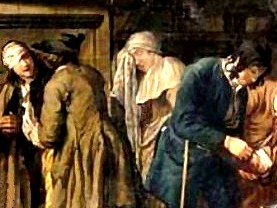
Artist: Jan Jozef
A Doctor with Patients, "A doctors surgery" (18th c.)
Venereal diseases were figured to be the fault of the sailor, first because they were contracted while the sailor was off the ship and second because they were the result of an immoral act. Sea surgeon John Moyle explained that there was a "Distemper which Seamen meet sometimes with by going a shore, and that is a Clap [gonorrhea]. Now for as much as this is not got by the Ships work, so it is not cured on the Ships account, but the Man pays you for it: But it is a Chyrurgical Cure, and you are desired by the Man to cure him."1 Note that the pragmatic Moyle makes no mention of the moral facet.
Although Moyle doesn't indicate the cost of the cure, modern historian Kevin Brown says that "until 1795 men reporting to the ship’s surgeon for treatment were fined 15s [75 pence] for their cure."2 It is interesting that is referred to by Brown as a fine; Moyle simply suggests that it is payment for the surgeon's services in dealing with a problem that was not a part of the ship's business.
Beginning in the late 17th century, naval surgeons were required to keep a journal of the treatments they gave to the sailors. Historian Jonathan Goddard points out that it was not required to keep record of venereal diseases treatment in these journals.
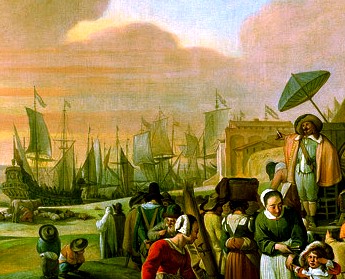
Artist: Jacob de Moor
A Quack Hawking His Wares, "Southern harbor scene with
charlatan"
(17th/18th c.)
"The reason for this was that venereal disease was viewed differently in the eyes of the navy. The contracting of this disease was not seen as unfortunate or merely careless, but as sinful and sailors who had it were fined."3
Sailors had it better than those on land, however. Historian Guy Williams points out that in hospitals, venereal victims who had gotten the disease through illicit sexual encounters "had to pay more for the treatment they received, and for their accommodation, than ‘clean’ patients. And why not? They were there, as a direct result of their own self-indulgence, and were being divinely punished, most people believed, for their immoral conduct."4
Brown points out an unintended consequence of this charge. Rather than pay it and admit to the ship's surgeon that they had the problem; "many men resorted to quack cures, shared medicines with their messmates, and only reported to the surgeon when ‘the most excruciating and dangerous symptoms had supervened.’"5 Goddard notes that when surgeons did record treating sailors for venereal diseases during the Napoleonic period, "it is noted [that many of them], had already tried the cures of quack doctors on shore but to no avail."6
Pirates also paid for VD, although not necessarily with cash. Their payment was often in untreated suffering since it was difficult for many golden age pirates to stop at a civilized port. Their best hope of a cure came through their captures. When Edward England's pirates managed to take East India Captain James Macrae's ship Cassandra, one newspaper explained, "It is believed that the Cassandra had 40000 l. of foreign Silver on board; but no Part of the Cargo was so much valued by the Robbers as the Doctor’s Chest, for they were all pox’d to a great Degree."7
1 John Moyle, Abstractum Chirurgæ Marinæ, 1686, p. 89; 2 Kevin Brown, Poxed and Scurvied: The Story of Sickness and Health at Sea, 2011, p. 96; 3 Jonathan Charles Goddard, "An insight into the life of Royal Naval surgeons during the Napoleonic War, Part 2," Journal of the Royal Naval Medical Service, Spring 1992, p. 219; 4 Guy Williams, The Age of Agony, 1986, p. 81; 5 Brown, p. 96; 6 Goddard, p. 219; 7 Applebee’s Original Weekly Journal, 4-22-21
Understanding VD in the GAoP: The Universal Source Theory
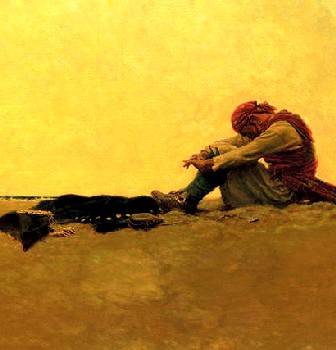
Artist: Howard Pyle - "Marooned" (1909)
The Universal Source Theory of venereal diseases is perhaps the most important concept needed to understand how venereal diseases were treated at this time. Modern historian Guy Williams explains: "During the eighteenth century, gonorrhoea, soft chancre and syphilis were all usually lumped communally together under some such label as ‘the foul disease’, or more colloquially, ‘the pox.’"1 Claude Quétel agrees, pointing out that gonorrhea, chancroid and syphilis were at this time understood to be "one and the same ailment."2 Quétel says that this theory held sway throughout the entirety of the golden age of piracy and beyond, not being seriously challenged until Francis Balfour published a thesis in Edinburgh in 1767 claiming that gonorrhea and syphilis were two different diseases which were produced by two different poisons.3 The third problem lumped into the universal venereal disease was chancroid (also called soft chancre). These are painful sores which appear on the genitals. This was not identified as a separate illness until 1852 when Leon Bassereau identified them as being distinct from syphilis.4
Under the Universal Source Theory understanding, golden age of piracy era physicians and surgeons though that venereal disease progressed through stages and, if treated quickly and appropriately, the later stages could be prevented. Naval physician William Cockburn gives the most thorough explanations about this in his 1713 book on gonorrhea. He explains that "Shankers [soft chancres] far less dispose men to be Poxed [get syphilis], than a Gonorrhœa does."5
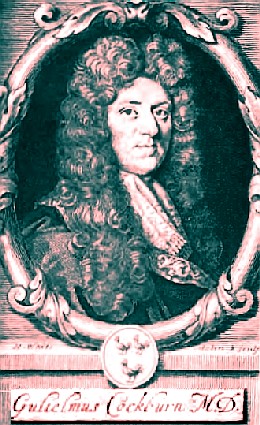
Physician William Cockburn
In other words, soft chancres, if treated properly, were less likely to degenerate into syphilis than gonorrhea. Note that one feature of syphilis is that it displays a wide variety of symptoms which do not all occur in each patient, with several symptoms that are the same as other illnesses. (This will be discussed in greater detail in the section on the history of venereal diseases.) As a result, it is likely that some of the symptoms perceived to be the gonorrhea 'stage' of venereal disease were actually just the early symptoms of syphilis.
German military physician Matthias Gottfried Purmann noted that "it is not asserted that a Pox [syphilis] does always gradually proceed from a Clap [gonorrhea], No for sometimes the Venemous matter is so subtil and agile, that it insinuates itself into the Blood, without causing a Clap."6 This suggests that the medical men recognized that the gonorrhea 'stage' could sometimes be skipped entirely, going from early symptoms directly to syphilis.
The idea that the venereal taint invaded the body through the blood permeates Cockburn's understanding of the Universal Source Theory. He states that syphilis could not be contracted "while the Running continues; the Contagion being then voided by the Genitals."7 The 'running' he is referring to here is a discharge of white, yellow, or green emission from the genitals, one of the more notable symptoms of gonorrhea. Cockburn explained that if medicines were given that would prevent this discharge, "it flows into the Blood, corrupts it, and is the Cause of the Pox."8 Based on this idea, Cockburn posited that "the Matter of the Pox is a Poyson, which has a Power to change some other Liquors [liquids] into its own corrosive Nature"9. When describing gonorrhea, sea surgeon John Atkins similarly said "in an improper handling, the Virulency will revert into the Blood, and produce all the Symptoms of a Pox"10.
Such ideas fit nicely with humor theory which suggests that the body's health is controlled by fluid 'humors'. When the humors were corrupted, they resulted in illness. In venereal diseases, it made sense to doctors from this era that the contaminated fluids received during sexual contact would invade the body and corrupt the body's humors.
1 Guy Williams, The Age of Agony, 1986, p. 81; 2 Claude Quétel, History of Syphilis, 1990, p. 38; 3 Quétel, p. 82; 4 King K. Holmes et al, Sexually Transmitted Diseases, 4th ed., 2007. p. 689; 5 William Cockburn, The Symptoms, Nature, Cause and Cure of a Gonorrhoea, 1713, p. 156; 6 Matthias Gottfried Purmann, Churgia Curiosa, 1706, p. 341; 7,8 Cockburn, p. 58; 9 Cockburn, p. 58-9; 10 John Atkins, Lues Venerea, p. 13
Understanding VD in the GAoP: Prevention
Artist: John Collett
"The Mutual Embrace" (1774)
There was some ideas presented in the medical books about how venereal diseases could be prevented (other than in the most obvious manner.) Sea surgeon John Atkins mentioned a method which involved keeping the sex organs clean. He noted that it was the "Custom in many foreign Countries of washing the Privities well after Coition, (to wit,) that they find it preventative of Infection; and, perhaps, Circumcision was not instituted by that renowned Law-Giver Moses, or the Impostor Mahomet, nor practised by ancienter Nations, without a View to the Cleanliness of this Part, and Prevention of foul and loathsome Distempers."1
Some countries even tried to prevent sailors from bringing venereal disease into ports by quarantining the ship until the men aboard had been inspected for the problem. Sea surgeon James Yonge describes the process when his merchant ship Robert Bonaventure made port in Messina, Italy in 1665.
After we had been a while there [anchored at the mouth of the bay where Messina sits], no one suffered [was allowed] to come ashore, we are all hands called out of the ship and directed to a small quadrangle, where an old fellow, perusing the bill of health we had from Genoa, puts on a great pair of spectacles as big as saucers and, making each man expose his groins and armpits, he looks into them and with a stick thrusts in them, where, finding nothing, we are allowed prattick [pratique - permission to come ashore], and then went into the town. One of our men who came from Genoa with a bubo [a sore in the genitals] was quite cured, for I purged and sealed it off, so as he was well and nothing showed but the want of hair [most likely baldness caused by being given mercury to 'cure' the problem], tho our man earnestly lookt into it and see if he could find what he suspected.2
Atkins mentions a similar tactic being employed when buying slaves along the African coast for transport by merchant ships. He explained that all slaves were examined to be sure they were "free of Venereal Taint", a factor which "governs our choice in buying."3
Some modern writers like to point to historical sources who mention the use of devices similar to condoms as an example of how forward thinking earlier civilizations were.
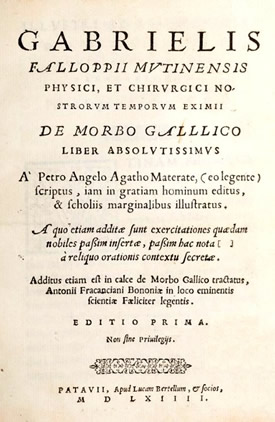
Gabriele Falloppio's De Morbo Gallico (1564)
However, condoms were not in wide use, nor were they understood as a method for preventing venereal diseases until the 19th century. Naval physician William Cockburn does mention a sort of condom in his treatise on gonorrhea which was originally described by Italian physician Gabriele Falloppio in his 1564 book De Morbo Gallico.
Cockburn quotes Falloppio's original manuscript at length, which explains that he "contrived a Linnen drenched in a Medicine; which Linnen may easily enough be carried about you; since you wear such Breeches... Wash, then, or wipe the Penis with this Linnen, and after Coition: Then have a piece of Linnen ready prepared and fitted for the Glans [the head of the penis], apply it, and let the Prepuce [foreskin] return to cover both."4
From this description, it appears that this piece of linen was not used during sex, but afterwards. Cockburn further notes that the linen is to be left "covering it for 4 or 5 Hours"5. Even if the sheath had been meant to prevent fluids from being exchanged during sex, it would not have worked since the porosity of linen would have done little to prevent the flow of venereal matter.
Cockburn further points out the a key to Falloppio's linen covering was that it was coated with "a Medicine ...that will penetrate Leather, and afterwards either dissipate, extract, dry away, or subdue any Matter contain’d in it."6 So the sheath was really being used as a medium to contain and deliver medicine, with a secondary focus on cleanliness of the genitals, similar to what Atkins was talking about. Although this method would likely have done little to prevent the spread of venereal disease, Falloppio claims, "I have made the Experiment on 1100 Men, and not one of them have been infected."7
Cockburn provides Falloppio's prescription for making the linen sheath. (Not only that, he provides a revised version!) The script is a bit arcane (and my Latin translation skills may leave a little to be desired), but here is original prescription:
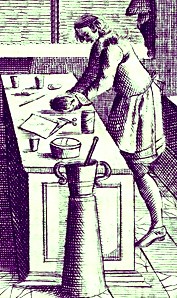
An Apothecary at Work, From
Georgica Curiosa Aucta (1697)
Rx. Radic Gentian. Aristoloch long. Tenuis rotundæ [thin root of Aristolochia rotunda], {of each 1 scruple} pulver. [powdered] sandal. albor. rubeor. Spodii ex Ebore [putty from ivory], C. Cervi usti [burnt], {of each, half scruple} fol. [leaves of] Scord. [water germander] Sanchi. Beton[y]. Scabios[a]. Tormentill. [Potentilla erecta] {of each 1.5 minums} Scob. [shavings of] Guaiac[um]. {2 ounces} Squam. Ær. [possibly Lathraea squamaria - toothwort] {2 drams} præcipitati præparat. [mercury precipitate] {1.5 drams} Vin. malvatic. [Malvasia wine] optim. potentis [strongest] {1.5 pounds} Aq. Sonch. Scabios. [simple water of one of the sonchus plants] {2 pounds} Assumitur Vinum et Aqua [The wine and water is mixed with the ingredients], et in his infunditur [and in them injected] Scobs Guaiaci [guaiac bark shavings] per 24 Horas [for 24 hours]. Deinde addenture reliquor omnia [then add the rest], & bullion simul ad Consumptionem medietatis [and boil to the consumption of half], deide colature Decoctem, et exprimuntur Medicamenta ista diligentissime [then strain the medicine very carefully]. In hoc Decocto perturbato macerator per Noctem Pannus Linteus purissimus [Put this in boiled water, soaking the linen cloth overnight] deinde siccatur in Umbra [then let it dry in darkness], et hoc fit tribus vicibus [which is done three times in succession]: Ter enim maceramus: [soaking three times]: Ter etiam siccamus [drying three times], Postea paramus frusta ad proportionem [after preparing a portion of the powder] propia Glandis [place on the end of the penis - glans], et sember babentur in Marsupiolo [and always have it in a pouch] vel in cavo illius partis Femoralium [or in a space in the undergarments], quæ Braccchetta dicitur [which is called Brachetta].8
If the long list of medicines used to prepare this little piece of linen are not enough to suggest that its primary benefit to the wearer was medicinal, Cockburn notes that

Photo: J.J. Harrison - Cinnabar (Mercury Sulfate) on Dolomite (the white mineral in the image)
Falloppio adds yet another medicine to be used by those who "are fearful, and would have stronger Medicine"9. This is a fumigate, meant to be burnt so that the fumes may be taken in at the infected location. The medicine is: "Rx. Pulv [powdered] ros. rubr. [red rose leaves] Absynthii, Sandal rubr. [red sandalwood] {of each, 1.5 scruples} belzuini [??], Camphoræ [camphora], Thuris [frankincense], Aloes, Myrrhæ, {of each 2 scruples} Cinnabar. [mercury sulfide] {1.5 drams}. Præcipitati [mercury precipitate] {1 dram} M. et F. Pulv. {mix and make into a powder]"10. Cockburn explains that this powdered mixture is to be put into a chafing dish which, once smoking, "may be covered with a Paper made in the fashion of a Funnel, which may cover the Dish, and receive the Member [referring to the genitals] to be smoaked at the same time."11
Cockburn mentions another, contemporary author's recommendation for preventing gonorrhea, that suggested by French barber-surgeon Nicolas de Blégny. He notes that de Blégny restricts his preventative treatment

Author Nicolas de Blégny
to the genitals, "whose Activity he thinks may be restrained, by a Mixture of the Gross Humors... [which] may be prevented by applying a Composition upon the Penis of Men, or to the Vagina of Women, before the Act of Coition... or by washing and cleansing the Parts immediately after Coition"12. Here again we see the lack of understanding of the way in which venereal diseases are transmitted since the medicines can be applied either before or after sex. Cockburn goes on to quote de Blégny's long list of possible medicinal concoctions which will not be quoted here.
However, Cockburn states that Falloppio's sheath method is preferable to de Blégny's because he uses "a Medicine to penetrate Leather, or any Membranous Part with Muscular Fibres, there either to draw out any Substance imbibed in it; or, if that cannot be done, to dry it away; or else conquer its malignity in the Place"13. Comparing the two, Cockburn notes that Falloppio's methods "are very proper Designs, and could not fail of their due Effect... De Blegny, on the other hand, would varnish our Genitals, and make them as insensible as the Boards this Liquor was contrived for."14 de Blégny's prescriptions use Gum Ammoniac as a key component in his preventative applications. This is a gum resin which quickly hardens when cooled, which is why Cockburn refers to 'varnishing' here.
Cockburn goes on to point out, "It is stupid to think, that People, who run headlong into Dangerous Pleasures, would even acquiesce in a Method [which]... would answer the Loss of their Pleasure; And it must always be reckoned, that plaistering, [or] double skinning [using the resin-based medicine]... can [n]ever pass with Men of Strong Passions and Desires."15 This, of course, has always been the problem with any method used to prevent unwanted pregnancy or venereal diseases. Passion overrides sense and forethought. It is highly unlikely that pirates or sailors were concerned with such preventative medicines... provided they could even get access to them.
1 John Atkins, The Navy Surgeon, 1742, p. 230; 2 James Yonge, The Journal of James Yonge [1647-1721] Plymouth Surgeon, 1965, p. 75; 3 John Atkins, A Voyage to Guinea and Brazil, 1735, p. 179-80; 4 William Cockburn, The Symptoms, Nature, Cause and Cure of a Gonorrhoea, 1713, p. 178; 5 Cockburn, p. 179; 6 Cockburn, p. 177; 7 Cockburn, p. 178; 8 Cockburn, p. 179-80; 9,10 Cockburn, p. 181; 11 Cockburn, p. 182; 12 Cockburn, p. 182-3; 13 Cockburn, p. 185; 13 Cockburn, p. 185-6; 15 Cockburn, p. 186

